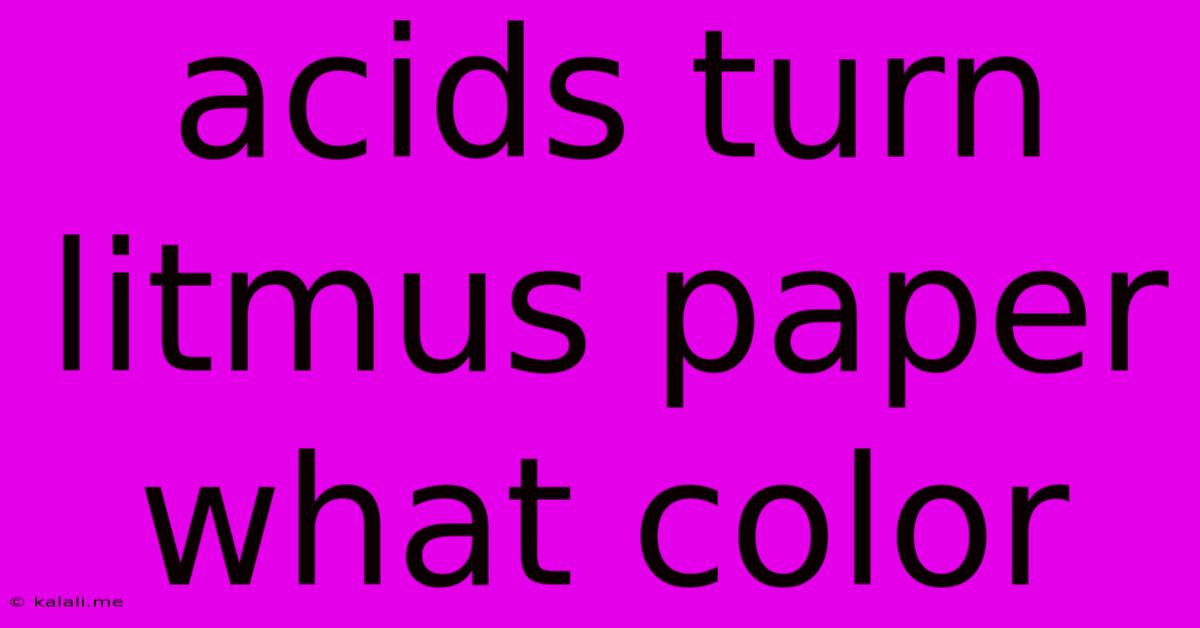Acids Turn Litmus Paper What Color
Kalali
Jun 15, 2025 · 3 min read

Table of Contents
Acids Turn Litmus Paper What Color? Understanding pH Indicators
This article will explore the fascinating world of pH indicators, focusing specifically on litmus paper and its reaction to acids. We'll delve into the science behind the color change and how this simple test helps us understand the acidity or alkalinity of a substance. Understanding pH is crucial in various fields, from chemistry and biology to environmental science and even cooking.
Litmus paper is a simple yet effective tool used to determine whether a solution is acidic or alkaline (basic). It's made from a mixture of different dyes extracted from lichens, and these dyes change color depending on the pH of the solution they're exposed to. The key question: what color does litmus paper turn when exposed to an acid? The answer is red.
The Science Behind the Color Change
The color change observed in litmus paper is a result of the interaction between the dye molecules and hydrogen ions (H⁺) present in acidic solutions. Acids, by definition, are substances that donate hydrogen ions when dissolved in water. This increase in H⁺ concentration causes a change in the chemical structure of the litmus dye molecules, leading to a shift in the wavelengths of light they absorb and reflect. This shift in absorption results in the visual change from blue to red.
Understanding the pH Scale
The pH scale is a logarithmic scale ranging from 0 to 14, with 7 representing neutrality. Solutions with a pH less than 7 are acidic, while those with a pH greater than 7 are alkaline (basic). Litmus paper provides a quick and easy way to get a general idea of a substance's pH. While it doesn't give a precise numerical value, it provides a clear indication of whether the substance is acidic (red) or alkaline (blue).
Beyond Litmus: Other pH Indicators
While litmus paper is a common and readily available indicator, many other substances can also indicate pH changes. These include:
- Phenolphthalein: This indicator turns colorless in acidic solutions and pink in alkaline solutions.
- Methyl orange: This indicator turns red in acidic solutions and yellow in alkaline solutions.
- Bromothymol blue: This indicator is yellow in acidic solutions, green in neutral solutions, and blue in alkaline solutions.
Each indicator has its own specific pH range where it undergoes a color change, making them useful for different applications.
Practical Applications of Litmus Paper
Litmus paper finds use in a variety of settings, including:
- Chemistry labs: To quickly determine the acidity or alkalinity of unknown solutions.
- Soil testing: To assess soil pH for optimal plant growth.
- Environmental monitoring: To test the pH of water samples to assess water quality.
- Home experiments: To conduct simple acid-base experiments.
Understanding the color change of litmus paper in acidic solutions is a fundamental concept in chemistry. The simple test provides valuable insights into the pH of a substance and its acidic or alkaline nature. While litmus paper offers a general indication, more precise pH measurements can be obtained using digital pH meters for more accurate results. Regardless of the method used, understanding pH is critical for numerous scientific and practical applications.
Latest Posts
Latest Posts
-
What Is Subliminal Perception In Psychology
Jun 15, 2025
-
Sat Requirements For Colorado State University
Jun 15, 2025
-
How Many Districts In Andhra Pradesh State
Jun 15, 2025
-
Can You Change Your Sat Date
Jun 15, 2025
-
The Si Unit Of Measure For Force Is
Jun 15, 2025
Related Post
Thank you for visiting our website which covers about Acids Turn Litmus Paper What Color . We hope the information provided has been useful to you. Feel free to contact us if you have any questions or need further assistance. See you next time and don't miss to bookmark.